The Huawei Ascend Mate 7 Review
by Andrei Frumusanu on December 2, 2014 8:00 AM EST- Posted in
- Smartphones
- Huawei
- Mobile
- Ascend Mate 7
- HiSilicon
GPU Performance
The graphics processing unit in the Kirin 925 remains unchanged from the one in the Kirin 920. It's the same ARM Mali T628MP4 running at 600MHz. What did change though, is the software. HiSilicon no longer employs such an aggressive GPU governor logic for the DVFS scaling, but adopted this time a more linear approach that scales from one frequency to the next, making it much less aggressive than the one found in the Honor 6.
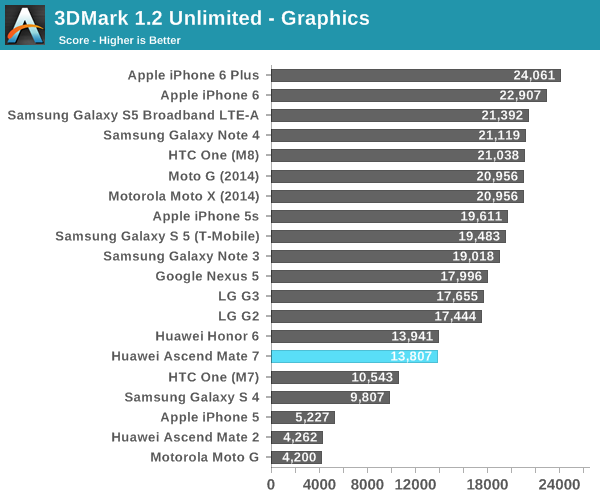
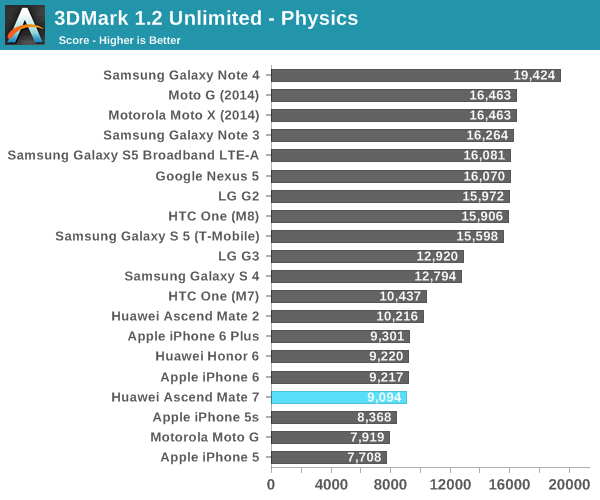
In 3DMark 1.2 Unlimited, we see no change compared to the Honor 6, as one would expect. The Physics score, which is dominantly CPU-bound, is more or less also unchanged. The Physics score here is rather low because the GTS mechanism limits the load onto the A7 scores, which have less performance headroom than the A15 cores. I don't see this as too much of a problem in real-world usage as the A7 cores should be able to handle most existing games without much issue, and it's in my opinion even a good thing as it brings down platform power down by quite a bit to avoid using the A15 cores.
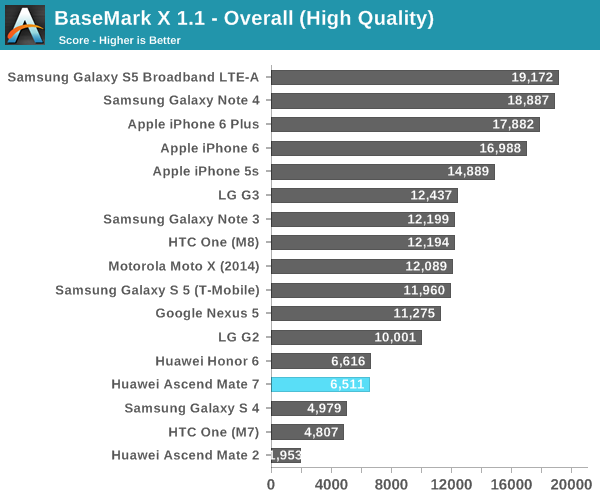
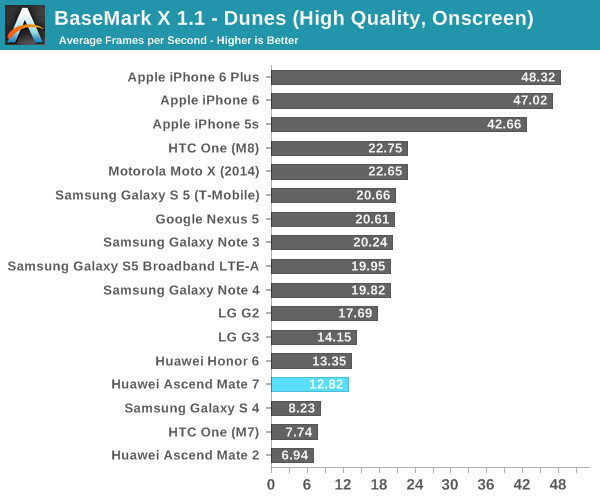
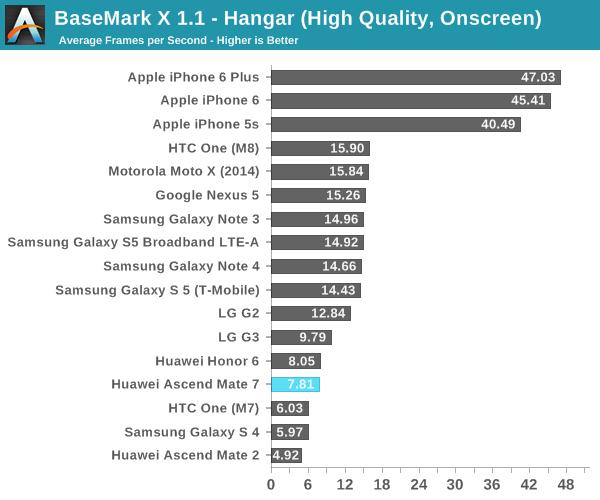

Checking in on BaseMark X 1.1, the Mali continues to be underwhelming. The MP4 configuration of the T628 is simply not enough to be able to compete with Qualcomm and Imagination's current high-end GPUs.


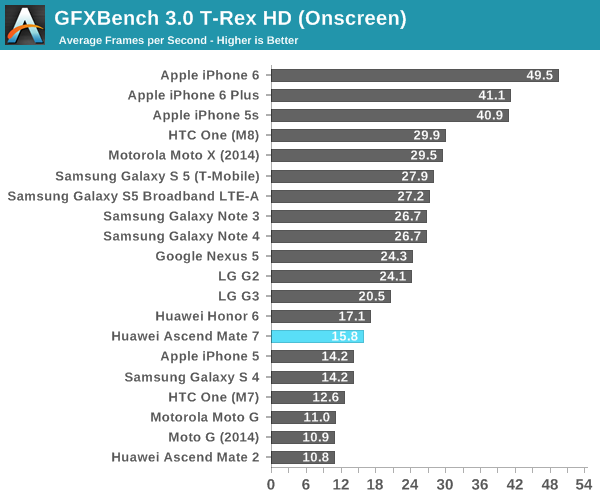

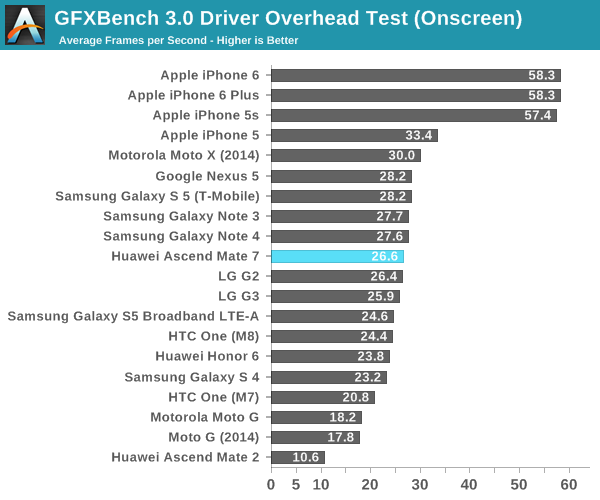
In GFXBench 3.0, the Mali is again dragging its feet and is barely capable of competing here. A lack of fill-rate performance is what is limiting it in the T-Rex benchmark, and a bottleneck in ALU power is what is stopping the Mali from performing better in the Manhattan test.
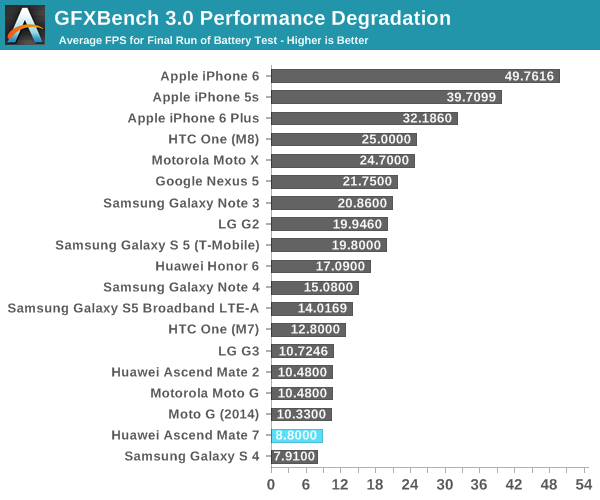
The biggest change I've seen between the Mate 7 and the Honor 6 is the way the GPU throttles. I've mentioned that I've had a hard time to get the Honor 6's GPU to throttle at all, and thus it performed quite well in our performance degradation metric. The Mate 7 seems to have changed its thermal policies and brings with it one of the worst scores we've every seen. It throttles very fast and limits itself to roughly half the frequency, resulting in only 8.8fps from the 15.8fps instant performance score. The result is that the Mate 7 performs much better in the GPU battery test, but before we get to that, let's characterize the screen of the Mate 7 so we can get a good notion of what we should expect in terms of battery life.










72 Comments
View All Comments
Laststop311 - Tuesday, December 2, 2014 - link
Wish we could have some american phones with battery life like this.arsjum - Tuesday, December 2, 2014 - link
Andrei,Any chance you'll be reviewing Galaxy Note 4 exynos version?
Andrei Frumusanu - Tuesday, December 2, 2014 - link
I've been working on the article for 2 weeks, it's coming.DanD85 - Tuesday, December 2, 2014 - link
Thanks for reviewing this Huawei phone, anandtech. These days, Chinese manufacturers have much more interesting devices compare to the old players. Anandtech has been my favorite tech review site for more than 10 years and you guy offer the most in depth review on the whole interweb. Keep up the great work!Sicariase - Wednesday, December 3, 2014 - link
Seriously Andrei, thanks for this review. I've been tossing up between the note 4 and this for a couple of weeks, and just decided to get the huawei (didn't think the differences were massive from other reviews) when this review came out. You've potentially saved me from a world of disappointment.Bondurant - Wednesday, December 3, 2014 - link
As with other reviews on this site, the problem in this review is that there is no corresponding reference to real life usage. Just lots of numbers but for example why not a real life gaming comparison between Mate 7 and Note 4 ? NAND performs horrible in benchmarks but if in real life there is barely any noticeable change, than does the benchmark score even matter ? How about comparing the photos with other 13MP IMX214 phones ? Also frustrating i found is there is no explanation as to what exactly is the cause of poor battery performance of Mate 7, is it the fault of GPU or their modem or that it does not use a amoled screen like Note 4 ? Is it a fixable issue with rom updates ?Ofcourse ideally Huawei could have simply thrown in some Qualcomm and so on like Samsung does, but it prevents the development of Hauwei's own innovations and implementations. HiSilicon from its last year K3V2 to this years Kirin 925, there is huge improvement and they are already releasing their 64bit chip kirin 930 this December and a Kirin 950 in June.
Andrei Frumusanu - Wednesday, December 3, 2014 - link
Basically the cause of bad battery life is that power consumption of the Kirin SoC is too high - I've explained this in the review of the Honor 6 where I took an in-depth look into the chip.Bondurant - Wednesday, December 3, 2014 - link
But a comparison between Honor 6 and Samsung S5 (both the Qualcomm and Exynos version) battery life don't show Kirin SOC having such suspected high battery drain problem, although yes you did mention ways battery life could have been improved but nothing to say of a huge problem.The case with Mate 7 on the other hand with 1000mAh more battery than Honor 6 does seem weird that the battery life improvements are only marginal.
Andrei Frumusanu - Monday, December 8, 2014 - link
I did point out that the Honor 6 is less efficient than competing devices.johnny_boy - Thursday, December 4, 2014 - link
Are you serious? I own an Honor 6 and I'm getting two days of battery life under normal usage (YouTube, Gmail, Gcal, pdf reading, etc.) Under light usage I can get 2.5-3 days. This is with wifi on and auto half brightness, which I find comfortable. I'm even using Firefox for Android with adblock for browsing which is likely worse on the battery than Chrome. Some REALISTIC battery life numbers would be pretty useful--like how long were you getting under what you deem light/normal/heavy usage?